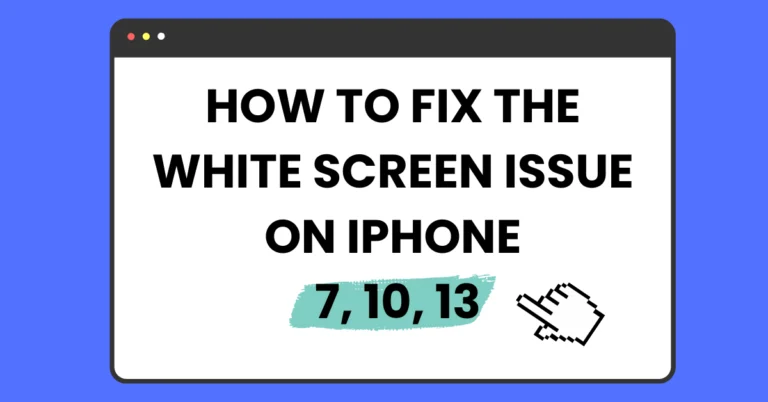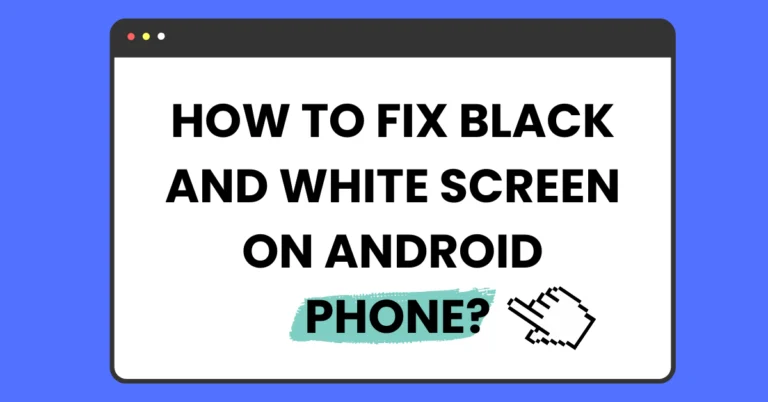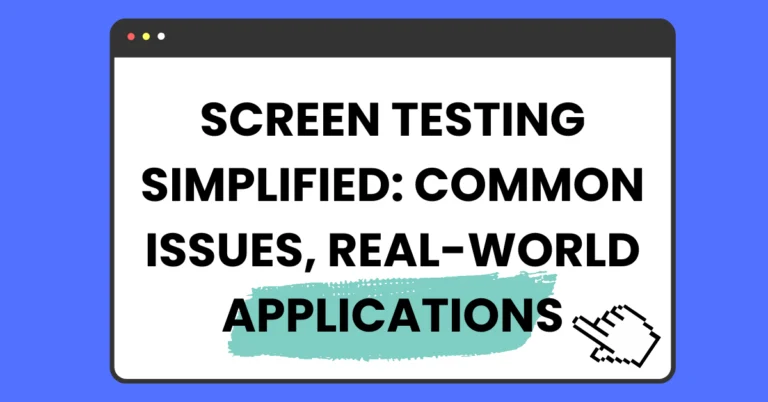How to Fix White Spots on a Phone Screen
White spots on phone screens can be frustrating and distracting, but they can be fixed with the right approach. This guide covers the causes, diagnosis, and solutions for white spots, including white dots on iPhone screens, spots on mobile screens, and more.
By following these steps, you can address and prevent these issues, ensuring your screen remains clear and functional.
Understanding the Causes of White Spots on Phone Screens
White spots on phone screens, often referred to as white dots on iPhone screens or spots on mobile screens, can be caused by several factors. Understanding these causes is crucial to diagnosing and fixing the issue effectively.
Pressure Damage
Pressure damage is one of the most common causes of white spots on phone screens. This occurs when excessive force is applied to the screen, causing damage to the liquid crystals in the LCD. This damage can result from sitting on the phone, dropping it, or even pressing too hard while cleaning. The damaged liquid crystals cannot display colors correctly, leading to bright white spots on the screen.
- Excessive Pressure: Excessive pressure from sitting on your phone, pressing the screen too hard, or dropping it can compress and damage the liquid crystals in the display. This often results in a bright spot on the phone screen.
- Signs of Pressure Damage: Look for areas on the screen that appear brighter than others, particularly when displaying a uniform color. These spots can be permanent if the pressure damage is severe.
Dead or Stuck Pixels
Pixels are the tiny dots that make up the display on your phone screen. Each pixel is composed of three subpixels: red, green, and blue. When these pixels fail to change color as needed, they can appear as white dots on the screen.
- Dead Pixels: These are pixels that do not light up at all. A dead pixel will typically appear as a black or white spot, regardless of the content on the screen.
- Stuck Pixels: These pixels are stuck on one color and do not change. They are more common than dead pixels and can sometimes be fixed using pixel-stimulation apps.
- Signs of Pixel Issues: These spots are usually small and noticeable against darker backgrounds. Running a screen test app can help identify and sometimes fix these pixels.
Water Damage
Water or moisture can cause significant damage to a phone’s internal components, including the screen. When water seeps into the phone, it can lead to discoloration and the formation of white spots.
- Exposure to Moisture: Phones exposed to moisture from rain, spills, or humid environments are at risk. Even a small amount of water can seep into the internal components and cause damage.
- Signs of Water Damage: White spots caused by water damage often appear alongside other symptoms, such as unresponsive buttons or erratic screen behavior. Look for signs of moisture under the screen, such as fogging or water droplets.
Manufacturing Defects
Some phones may have inherent defects from the manufacturing process. These defects may not be immediately apparent but can manifest over time as white spots on the screen.
- Defective Screens: Sometimes, the issue is due to a defect in the screen itself. Manufacturing defects can result in areas where the liquid crystals do not function properly, causing white spots.
- Signs of Manufacturing Defects: If the white spots appear shortly after purchasing the phone and without any external damage, it could be a manufacturing defect. Contacting the manufacturer for a warranty repair or replacement is recommended.
Aging Hardware
As phones age, the components within them can wear out, leading to various issues, including white spots on the screen. Over time, the backlight and liquid crystals in the display can degrade, causing these bright spots to appear.
- Wear and Tear: Regular use over several years can lead to wear and tear on the phone’s display components, resulting in white spots. This is especially common in older devices.
- Signs of Aging Hardware: Gradual appearance of white spots, often accompanied by other issues such as decreased battery life or slower performance, indicates aging hardware.
Diagnosing the Problem
Diagnosing the cause of white spots on your phone screen is the first step toward fixing them. Here are a few diagnostic checks to help you identify the issue:
Visual Inspection
Start with a thorough visual inspection of your phone screen. Look for any visible damage, such as cracks, scratches, or pressure marks.
- Check for Cracks or Scratches: Cracks and scratches can be a clear indicator of physical damage. Even small, hairline cracks can cause pressure points that lead to white spots.
- Look for Pressure Marks: Pressure marks may not be as obvious as cracks but can still cause white spots. These marks often appear as faint indentations or bright spots when the screen is turned off.
Screen Test Apps
Screen test apps can help you identify dead or stuck pixels. These apps cycle through different colors and patterns to help you spot issues with the display.
- Using Screen Test Apps: Download and run a screen test app like JScreenFix or Dead Pixel Fixer. These apps display a series of solid colors and patterns to help you identify problematic pixels.
- Identifying Problematic Pixels: As the app cycles through colors, look for pixels that do not change or appear as white spots. These are likely dead or stuck pixels that may require further action.
Introducing White Test Screen
White Test Screen is your 100% free web-based white screen tool for testing screens across devices like mobile phones, laptops, desktops, iPads, and iPhones. Our pure white screen enables thorough checks for dead spots, screen errors, and related issues. Whether you’re a professional or a curious user, enjoy a clean, customizable experience with features like adjustable pixel settings and the option to download the pure white screen background as wallpaper.
Additional Tools on White Test Screen
- Black Screen: Perfect for testing pixel response and detecting light leaks.
- Red Screen: Useful for identifying issues with red subpixels.
- Green Screen: Helps in testing green subpixel performance.
- Blue Screen: Ideal for checking the blue subpixels on your display.
- Orange Screen: Can be used for specific testing scenarios involving mixed colors.
- Pink Screen: Useful for detecting anomalies in pink subpixels.
- Purple Screen: Helps identify issues with purple subpixels.
- Off-White Screen: A subtle variation for detecting color consistency and uniformity.
Fun and Practical Tool: Fake Screen
Looking to pull off the ultimate prank on your friends, colleagues, or even your boss? Our free fake screen tool allows you to simulate various operating system screens, including Windows 7, 10, 11, Ubuntu, and macOS. Whether you want to pretend your system is undergoing a Windows update or show off the latest macOS interface, we’ve got you covered.
Safe Mode
Booting your phone in safe mode can help determine if the issue is caused by a third-party app. Safe mode disables all non-essential apps and services, allowing you to see if the white spots persist.
- Booting in Safe Mode on iPhone: For iPhones, safe mode can be accessed by holding the power button and then selecting “Safe Mode” from the options. This process varies slightly depending on the iPhone model.
- Booting in Safe Mode on Android: On Android phones, hold the power button until the power off icon appears, then press and hold “Power Off” until the safe mode prompt appears. Select “OK” to reboot in safe mode.
- Checking for White Spots in Safe Mode: If the white spots disappear in safe mode, a third-party app may be causing the issue. Try uninstalling recently added apps to identify the culprit.
Fixing Software-Related Issues
If the white spots are caused by software issues, try the following solutions:
- Update Your Software: Ensure your phone’s operating system is up-to-date. Software updates often include fixes for display issues.
- iPhone: Go to Settings > General > Software Update.
- Android: Go to Settings > System > Software Update.
- Factory Reset: If updating the software doesn’t help, consider performing a factory reset. This will erase all data, so back up your information first.
- iPhone: Settings > General > Reset > Erase All Content and Settings.
- Android: Settings > System > Reset options > Erase all data (factory reset).
Fixing Hardware-Related Issues
If the problem is hardware-related, consider the following steps:
- Screen Protector: Remove any screen protector to see if it’s causing the issue.
- Professional Repair: If the screen is physically damaged, it’s best to consult a professional repair service. They can replace the LCD or digitizer if necessary.
- Replace the Display: For severe damage, replacing the entire display may be the best option.
Advanced Solutions
- Pixel Stimulation: Use pixel-stimulation apps that rapidly cycle colors to try and revive stuck pixels.
- Heat Application: Carefully apply heat using a hairdryer on a low setting to the affected area to try and redistribute the liquid crystals. Be cautious not to overheat the device.
- Pressure Massage: Gently massage the affected area with a soft cloth to see if it can redistribute the liquid crystals.
Preventive Measures
To prevent white spots from appearing on your screen:
- Use a Quality Screen Protector: This can shield your screen from scratches and pressure damage.
- Avoid Excessive Pressure: Be mindful not to press too hard on the screen or place heavy objects on your phone.
- Keep Your Phone Dry: Protect your phone from moisture and use waterproof cases if necessary.
- Handle with Care: Avoid dropping or mishandling your phone to prevent internal damage.
Frequently Asked Questions
Why is there a bright spot on my phone screen?
Bright spots can be caused by excessive pressure on the LCD, dead pixels, or internal damage from moisture.
Can white dots on iPhone screens be fixed?
Yes, white dots on iPhone screens can often be fixed by addressing software issues or through professional hardware repair if the problem is due to physical damage.
What should I do if I see white dots on a black screen?
Use a screen test app to check for dead or stuck pixels. If detected, follow the software or hardware repair steps outlined above.
Are spots on mobile screens covered under warranty?
It depends on the cause. Manufacturer defects are typically covered, but damage from drops or moisture may not be.
How do I prevent spots from app?
Use screen protectors, avoid excessive pressure, keep your phone dry, and handle your device with care.
Conclusion
White spots on phone screens can be a nuisance, but with the right approach, they can often be fixed or prevented. By understanding the causes and solutions, you can take steps to ensure your screen remains clear and functional. Whether it’s through DIY fixes or professional repair, addressing these issues promptly can help maintain the longevity and usability of your phone. Regular maintenance and mindful usage are key to preventing such issues in the future.
Additional Tips and Insights
- Screen Calibration: Regularly calibrate your screen using built-in tools or third-party apps to ensure optimal performance and detect any issues early.
- Regular Cleaning: Clean your screen with a microfiber cloth to remove dust and fingerprints that can obscure the display and cause pressure marks.
- Check Battery Health: Sometimes, battery swelling can cause pressure on the screen from the inside, leading to white spots. Check your battery health and replace it if necessary.
- Use Quality Accessories: Poor quality cases and screen protectors can sometimes cause damage. Invest in high-quality accessories that offer proper protection without causing pressure or damage.





